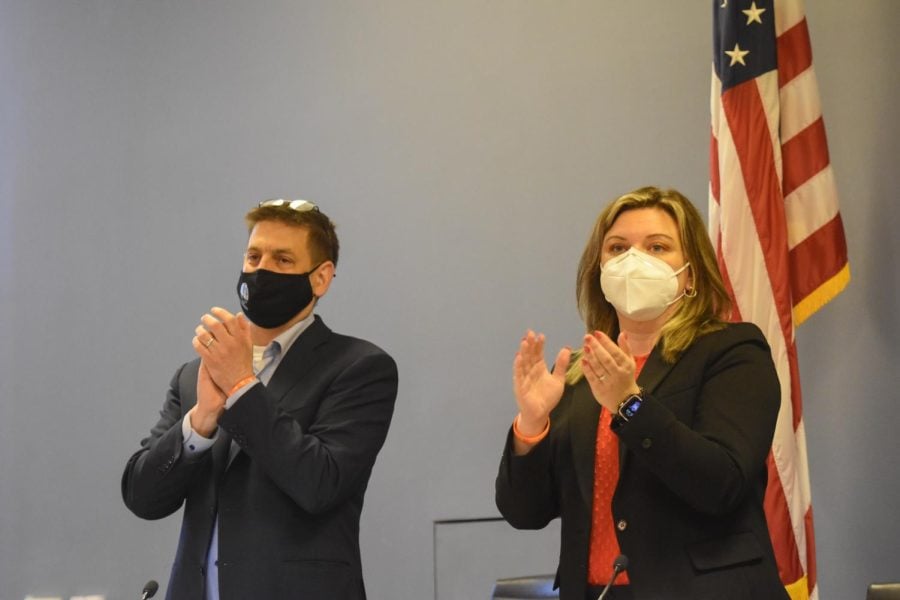Evanston Redistricting Committee discusses need for community engagement in planning meeting
Daily file photo by Jacob Wendler
Ald. Jonathan Nieuwsma (4th) stands with Interim City Manager Kelley Gandurski. On Tuesday, Nieuwsma led the city’s second Redistricting Committee meeting to plan out the redistricting process.
June 28, 2022
Residents can expect Evanston’s ward map to look a little different next year.
Evanston’s Redistricting Committee met Tuesday to discuss criteria for redrawing the city’s ward boundaries and plan next steps for community engagement. The city is redistricting for the first time in more than 20 years, following the release of 2020 U.S. Census Data.
“The reason we decided we need to redistrict is because the nine wards of the city of Evanston have grown out of balance,” Ald. Jonathan Nieuwsma (4th), who chairs the committee, said.
Some wards have much larger populations than others, which can affect voting power and representation. Each ward has an average of 8,679 residents, but individual populations vary widely. The 3rd Ward holds about 9,600 residents, while the 5th and 9th wards both have just under 8,000.
At the meeting, Nieuwsma presented the criteria for redrawing ward boundaries. The city has to consider criteria like respecting geographical boundaries, minimizing voter confusion, keeping communities of interest together, protection of incumbency and adhering to the Voting Rights Act of 1965, which prohibits racial discrimination in voting.
Ald. Melissa Wynne (3rd) said she was happy with the criteria listed but was confused by the “protection of incumbency” criteria, which she said wasn’t part of the conversation the last time the city redistricted in 2003. Wynne is the only current councilmember who served on the dais at that time.
In response, Nicholas Cummings, the city’s corporation counsel, said the incumbency criteria was taken from Michigan’s guidelines, which read that “the district shall not favor nor disfavor incumbency.” This means ward boundaries shouldn’t be drawn to keep an incumbent in office, nor should they be drawn to oust an incumbent from running again.
Wynne expressed appreciation for Cumming’s clarification.
“I like that language quite a bit,” she said.
Ald. Devon Reid (8th) added that if a councilmember was drawn out of their ward, they would still be able to run, as long as they move into the new district within a year.
The city’s last redistricting efforts in 2003 stirred up criticisms among residents and city leaders about diluting Black voting power.
After the meeting, Nieuwsma told The Daily he hopes the process will be much smoother and make fewer changes to ward boundaries than in 2003.
“By making some incremental adjustments we can accomplish this without too much controversy,” Nieuwsma said.
Nieuwsma said a robust public engagement rollout and new technology, such as websites that will draw new ward boundaries and automatically calculate demographic information, will make the redistricting process more streamlined.
To solicit resident feedback, the city will host a virtual redistricting town hall on July 13 and a Spanish language equivalent on July 20. The city will also host a series of five public meetings once a month from July through November to gather resident input. During Tuesday’s meeting, committee members agreed they would host the meetings by ward, asking residents from two specific, different wards to show up to each meeting.
Nieuwsma said he hopes to cast a wide net for resident input by combining traditional mailers with digital ads and newsletter bursts.
“I’d like to be proactive on this and intentionally reach out to stakeholder groups and individuals and make sure that they are aware of this opportunity,” Nieuwsma said.
The Redistricting Committee hopes to ask City Council for funding at a future City Council meeting to support research and funding. The committee plans to release map drafts in December and have the council vote on a new ward map in May 2023.
Email: [email protected]
Twitter: @yimingfuu
Related Stories:
— How the Evanston Complete Count Committee is preparing for the 2020 Census


